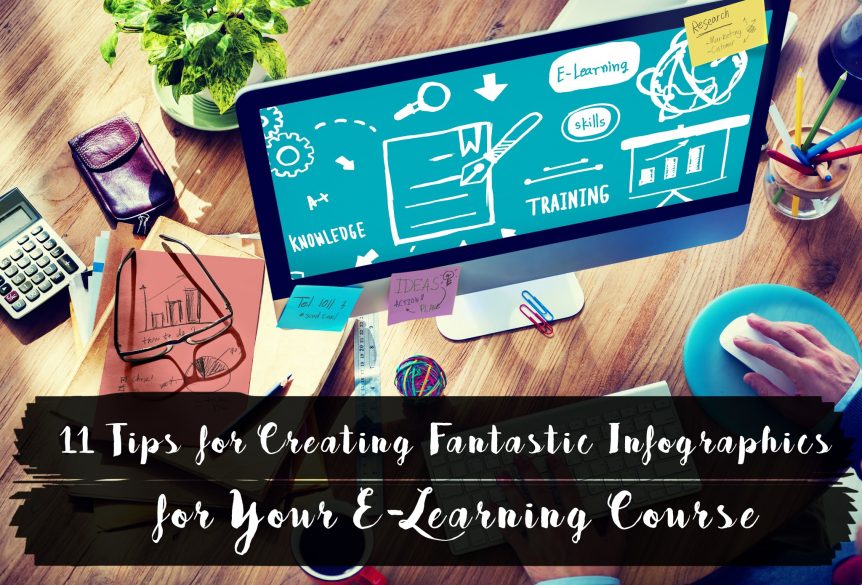11 Tips for Creating Fantastic Infographics for Your E-Learning Course
Infographics make it easier for learners to understand complex topics, particularly when those topics include a lot of facts and figures. They also make e-learning courses less cluttered and more visually appealing.
It’s easy to get an infographic wrong, however, as they are not a guaranteed engagement tool. So, you need to make sure you design your infographic so that it appeals to your learners. It must also facilitate the learning process and help you achieve your overall course objectives.
The following 11 tips for creating fantastic e-learning infographics will help with all the above.
1. Stay Focused
Your infographic should not go off on tangents and it shouldn’t confuse the learner.
Instead, its focus should be on a specific topic and it should have a specific purpose or goal.
If you are unsure of the purpose or goal, you should consider whether an infographic is the right approach. Importantly, you should never use an infographic just for the sake of having an infographic.
Always present the information in your e-learning course using a medium that will deliver the best results whether that is an infographic, text, video, an image, audio, or anything else.
2. Use Images
Infographics need images and text to make them visually appealing, with the graphics breaking up the text and adding creativity.
3. Use Professional and Relevant Images
Following on from the last point, don’t just use any images when designing e-learning infographics. Firstly, the infographics you use should be relevant to both the subject matter and the learner. Secondly, they should be professional, and they should match the style and design of your course.
You may need to purchase images to ensure you achieve the above, but it will be worth the investment.
Alternatively, use a professional e-learning developer in Dubai. Not only will they be skilled in the creation of infographics, but they will also have accounts that give them access to premium images.
4. Take it Easy on the Text
As mentioned above, your infographic will need text. Make sure you don’t use too much text, however.
This is because learners shouldn’t have to read your infographic in detail. Instead, they should be able to process the information at a glance.
If you find you have to add too much text, you should consider if an infographic is the best option for presenting the information.
5. Keep Your Design Uncluttered
Cluttered designs make infographics difficult to read and process, completely negating the benefits they offer. So, make sure the design of your e-learning infographic is uncluttered.
6. Don’t Make it Too Long
Infographics run vertically down the page, making them easy to read even when the infographic is long. Don’t make your e-learning infographic too long, however, by trying to include too much information.
To avoid this, remember the first point on this list about keeping the infographic focused on a specific topic. For anything else, use different methods and different parts of your e-learning course.
7. Remember that Learners Read Information Left to Right
While infographics are usually long (i.e. longer than the height of most screens they are viewed on), your learners will still read and process the information from left to right. They will do this as they scroll down.
Therefore, make sure you facilitate this in your design to prevent learners from missing crucial information.
8. Keep Your Design Consistent
The design of your e-learning infographic should be consistent with the design of the rest of the e-learning course. This will ensure learners view it as an integral part of the course.
In addition, it’s important your infographic is consistent with your brand.
9. Make Sure You Create a Fresh Design
It can be tempting to copy designs from previous infographics to save time during the creative process. This can make your infographic look stale, however, particularly for those who have seen the design before.
Instead, you should make sure all your designs are fresh.
This doesn’t mean you can’t use infographic templates. Templates are helpful when creating infographics for e-learning courses, but you should still make sure the design you create within that template is unique.
10. Don’t Use Too Many Colours
Infographics with too many colours can become difficult to read and process. They also look unprofessional.
You will always need more than one colour, of course, to ensure the infographic is attractive and to make it easy for learners to follow. However, don’t use too many.
The ideal approach is to use a colour palette that has three or four colours. You can stretch to five and even six in some circumstances, but you should always aim for as few as possible.
11. Write Engaging Text
The focus for many people designing e-learning infographics is on the visuals. This is understandable as infographics are visual elements. However, the information within an infographic is in the form of text. Therefore, you should not neglect the text
Specifically, you should ensure the text you use on e-learning infographics is interesting, engaging, and informative.
Including Infographics In E-Learning Courses
Infographics can, when properly designed, make dull and hard to follow topics easy to understand and digest. This means they are important to the success of your course. The above tips will help make sure yours are as good as possible.
